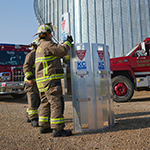Technology and bin safety
The best way to prevent serious injury or death from working in or around grain bins is to avoid entry altogether. There’s also new technology that makes grain bin work safer for farmers and farm workers.
Remote, autonomous and robotic tools and equipment help ensure stored grain is in good condition. They also prevent the need for a person to enter a bin to do some of the most common jobs like sweeping grain and checking its quality. This ultimately helps mitigate the risk to farmers and farm workers associated with working in and around grain bins.
Remote, automated and robotic: What’s the difference?
There are distinct differences between remote, automated and robotic tools for working around stored grain. Remote tools are controlled directly by a human operator, while automated technology is programmed by an operator then completes a task without additional human involvement.
Robotic technology grain management tools and equipment “think” on their own. Once a specific task is defined, robotic tools use combinations of equipment, sensors and programming to do a job like breaking up crusted grain or dissipating heat or moisture in stored grain. This work is done with no additional human involvement.
Examples of the tools and how they work
Remote grain management systems and tools range widely. Some tools monitor grain condition inside a bin. Other machines prevent grain from clumping and building up around places like augers inside bins. They all have one thing in common. They require a human operator to control the equipment. The Sump Saver is an example of a remote grain management tool. Controlled by a human operator, it helps prevent the buildup of crusted grain around an auger inside of a grain bin.
Automated grain management tools combine monitors and sensors with specific purpose-driven equipment. Though it doesn’t “think” on its own, automated equipment often uses software to guide its work. The Grain Weevil grain bin management robot — though not truly robotic — uses algorithms to determine optimal machine tracking to break up crusted and bridged grain inside a bin.
Finally, robotic grain management tools take automation to a new level. Robotic systems “think” on their own, assessing grain conditions and taking action to do things like keep grain flowing into an auger without human intervention. Robotic tools and systems build on remote and automated systems by “learning” how to efficiently do jobs like sweeping bin floors with no human interaction.
Find which type of grain bin technology is best for you
Technology attitudes and aptitude will go a long way to determining which level of grain management system or tool is best for you. Cost is also a factor; newer automated tools typically have higher price tags than simpler remote or manual tools. Robotic tools currently have the highest prices today, largely because the technology is relatively new. The technology is rapidly evolving, so robotic grain monitoring tools will likely be more readily available in the coming years.
Talk to your Nationwide Farm Certified agent and other grain safety experts to determine which type of grain management technology is right for you.

 >
>

 >
>
 >
>